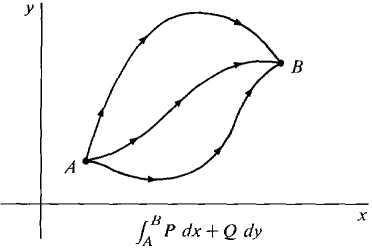| The ebook Elementary Calculus is based on material originally written by H.J. Keisler. For more information please read the copyright pages. |

|

Home  Vector Calculus Vector Calculus  Independence of Path Independence of Path  Theorem 2 (Path Independence Theorem) Theorem 2 (Path Independence Theorem) |
|||||||






|
|||||||
Theorem 2 (Path Independence Theorem)
THEOREM 2 (Path Independence Theorem) Let Pi + Qj be a vector field such that ∂P/∂y = ∂Q/∂x and let A and B be two points of D. (i) Let f be a potential function for Pi + Qj. For any piecewise smooth curve C from A to B,
Since the line integral in this case depends only on the points A and B and not on the curve C (Figure 13.3.1), we write
(ii) g is a potential function for Pi + Qj if and only if g has the form
for some constant K.
Figure 13.3.1: Independence of path Theorem 2 is important in physics. A vector field of forces which has a potential function is called a conservative force field. The negative of a potential function for a conservative force field is called a potential energy function. Gravity, static electricity, and magnetism are conservative force fields. Part (i) of the theorem shows that the work done by a conservative force field along a curve depends only on the initial and terminal points of the curve and is equal to the decrease in potential energy. Mathematically, Theorem 2 is like the Fundamental Theorem of Calculus. It shows that the line integral of grad f along any curve from A to B is equal to the change in the value of f from A to B. When A = B, we have an interesting consequence : If f(x, y) has continuous second partials then the line integral of the gradient of f around a simple closed curve is zero,
Using part (ii), we can find a potential function f(x, y) for a vector field Pi + Qj in three steps. When to Use
We postpone the proof of Theorem 2 to the end of this section.
|
|||||||
Home  Vector Calculus Vector Calculus  Independence of Path Independence of Path  Theorem 2 (Path Independence Theorem) Theorem 2 (Path Independence Theorem) |
|||||||
Last Update: 2006-11-22








